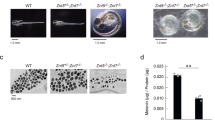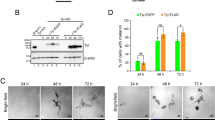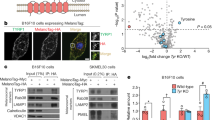Abstract
Copper is a cofactor for many cellular enzymes and transporters1. It can be loaded onto secreted and endomembrane cuproproteins by translocation from the cytosol into membrane-bound organelles by ATP7A or ATP7B transporters, the genes for which are mutated in the copper imbalance syndromes Menkes disease and Wilson disease, respectively2. Endomembrane cuproproteins are thought to incorporate copper stably on transit through the trans-Golgi network, in which ATP7A accumulates3 by dynamic cycling through early endocytic compartments4. Here we show that the pigment-cell-specific cuproenzyme tyrosinase acquires copper only transiently and inefficiently within the trans-Golgi network of mouse melanocytes. To catalyse melanin synthesis, tyrosinase is subsequently reloaded with copper within specialized organelles called melanosomes. Copper is supplied to melanosomes by ATP7A, a cohort of which localizes to melanosomes in a biogenesis of lysosome-related organelles complex-1 (BLOC-1)-dependent manner. These results indicate that cell-type-specific localization of a metal transporter is required to sustain metallation of an endomembrane cuproenzyme, providing a mechanism for exquisite spatial control of metalloenzyme activity. Moreover, because BLOC-1 subunits are mutated in subtypes of the genetic disease Hermansky–Pudlak syndrome, these results also show that defects in copper transporter localization contribute to hypopigmentation, and hence perhaps other systemic defects, in Hermansky–Pudlak syndrome.
This is a preview of subscription content, access via your institution
Access options
Subscribe to this journal
Receive 51 print issues and online access
$199.00 per year
only $3.90 per issue
Buy this article
- Purchase on Springer Link
- Instant access to full article PDF
Prices may be subject to local taxes which are calculated during checkout




Similar content being viewed by others
References
Thiele, D. J. Integrating trace element metabolism from the cell to the whole organism. J. Nutr. 133, 1579S–1580S (2003)
Mercer, J. F. The molecular basis of copper-transport diseases. Trends Mol. Med. 7, 64–69 (2001)
Yamaguchi, Y. et al. Biochemical characterization and intracellular localization of the Menkes disease protein. Proc. Natl Acad. Sci. USA 93, 14030–14035 (1996)
Harris, E. D. Cellular copper transport and metabolism. Annu. Rev. Nutr. 20, 291–310 (2000)
Lutsenko, S. et al. Function and regulation of human copper-transporting ATPases. Physiol. Rev. 87, 1011–1046 (2007)
Marks, M. S. & Seabra, M. C. The melanosome: membrane dynamics in black and white. Nature Rev. Mol. Cell Biol. 2, 738–748 (2001)
Oetting, W. S. et al. Oculocutaneous albinism type 1: the last 100 years. Pigment Cell Res. 16, 307–311 (2003)
Novikoff, A. B., Albala, A. & Biempica, L. Ultrastructural and cytochemical observations on B-16 and Harding–Passey mouse melanomas. The origin of premelanosomes and compound melanosomes. J. Histochem. Cytochem. 16, 299–319 (1968)
Maul, G. G. & Brumbaugh, J. A. On the possible function of coated vesicles in melanogenesis of the regenerating fowl feather. J. Cell Biol. 48, 41–48 (1971)
Petris, M. J., Strausak, D. & Mercer, J. F. The Menkes copper transporter is required for the activation of tyrosinase. Hum. Mol. Genet. 9, 2845–2851 (2000)
Levinson, B. et al. The mottled gene is the mouse homologue of the Menkes disease gene. Nature Genet. 6, 369–373 (1994)
Mercer, J. F. et al. Mutations in the murine homologue of the Menkes gene in dappled and blotchy mice. Nature Genet. 6, 374–378 (1994)
Wei, M. L. Hermansky–Pudlak syndrome: a disease of protein trafficking and organelle function. Pigment Cell Res. 19, 19–42 (2006)
Gautam, R. et al. Interaction of Hermansky–Pudlak syndrome genes in the regulation of lysosome-related organelles. Traffic 7, 779–792 (2006)
Setty, S. R. et al. BLOC-1 is required for cargo-specific sorting from vacuolar early endosomes toward lysosome-related organelles. Mol. Biol. Cell 18, 768–780 (2007)
Theos, A. C. et al. Functions of adaptor protein (AP)-3 and AP-1 in tyrosinase sorting from endosomes to melanosomes. Mol. Biol. Cell 16, 5356–5372 (2005)
Chi, A. et al. Proteomic and bioinformatic characterization of the biogenesis and function of melanosomes. J. Proteome Res. 5, 3135–3144 (2006)
Starcevic, M. & Dell’Angelica, E. C. Identification of snapin and three novel proteins (BLOS1, BLOS2, and BLOS3/reduced pigmentation) as subunits of biogenesis of lysosome-related organelles complex-1 (BLOC-1). J. Biol. Chem. 279, 28393–28401 (2004)
Gwynn, B. et al. Reduced pigmentation (rp), a mouse model of Hermansky–Pudlak syndrome, encodes a novel component of the BLOC-1 complex. Blood 104, 3181–3189 (2004)
Sato, M. & Gitlin, J. D. Mechanisms of copper incorporation during the biosynthesis of human ceruloplasmin. J. Biol. Chem. 266, 5128–5134 (1991)
De, M. et al. Trafficking of a secretory granule membrane protein is sensitive to copper. J. Biol. Chem. 282, 23362–23371 (2007)
Wang, N. & Hebert, D. N. Tyrosinase maturation through the mammalian secretory pathway: bringing color to life. Pigment Cell Res. 19, 3–18 (2006)
Martinez, J. H. et al. The involvement of histidine at the active site of Harding–Passey mouse melanoma tyrosinase. Biochem. Int. 11, 729–738 (1985)
Raposo, G. et al. Distinct protein sorting and localization to premelanosomes, melanosomes, and lysosomes in pigmented melanocytic cells. J. Cell Biol. 152, 809–824 (2001)
Raposo, G. & Marks, M. S. Melanosomes—dark organelles enlighten endosomal membrane transport. Nature Rev. Mol. Cell Biol. 8, 786–797 (2007)
Raposo, G., Marks, M. S. & Cutler, D. F. Lysosome-related organelles: driving post-Golgi compartments into specialisation. Curr. Opin. Cell Biol. 19, 394–401 (2007)
Salazar, G. et al. BLOC-1 complex deficiency alters the targeting of adaptor protein complex-3 cargoes. Mol. Biol. Cell 17, 4014–4026 (2006)
Krajacic, P. et al. Retinal localization and copper-dependent relocalization of the Wilson and Menkes disease proteins. Invest. Ophthalmol. Vis. Sci. 47, 3129–3134 (2006)
Lopes, V. S. et al. Melanosome maturation defect in Rab38-deficient retinal pigment epithelium results in instability of immature melanosomes during transient melanogenesis. Mol. Biol. Cell 18, 3914–3927 (2007)
Boissy, R. E., Zhao, Y. & Gahl, W. A. Altered protein localization in melanocytes from Hermansky–Pudlak syndrome: support for the role of the HPS gene product in intracellular trafficking. Lab. Invest. 78, 1037–1048 (1998)
Hamza, I., Prohaska, J. & Gitlin, J. D. Essential role for Atox1 in the copper-mediated intracellular trafficking of the Menkes ATPase. Proc. Natl Acad. Sci. USA 100, 1215–1220 (2003)
Sviderskaya, E. V. et al. p16(Ink4a) in melanocyte senescence and differentiation. J. Natl. Cancer Inst. 94, 446–454 (2002)
Bennett, D. C. et al. Cloned mouse melanocyte lines carrying the germline mutations albino and brown: complementation in culture. Development 105, 379–385 (1989)
Yoshino, A. et al. tGolgin-1 (p230, golgin-245) modulates Shiga-toxin transport to the Golgi and Golgi motility towards the microtubule-organizing centre. J. Cell Sci. 118, 2279–2293 (2005)
Reynolds, E. S. The use of lead citrate at high pH as an electron-opaque stain in electron microscopy. J. Cell Biol. 17, 208–212 (1963)
Berson, J. F. et al. Pmel17 initiates premelanosome morphogenesis within multivesicular bodies. Mol. Biol. Cell 12, 3451–3464 (2001)
Acknowledgements
We thank J. Gitlin, M. Petris, B. Eipper, S. Lutsenko and A. Peden for reagents; A. Dancis, L. King and C. Burd for comments; and D. Harper for technical assistance. This work was supported by National Institute of Health grants R01 EY015625 and R21 GM078474 (to M.S.M.), CNRS, Institut Curie and Fondation pour la Recherche Médicale (to G.R.), Wellcome Trust program grant 064583 (to E.V.S. and D.C.B.), and postdoctoral fellowship 0625437U from the American Heart Association (to S.R.G.S.).
Author Contributions S.R.G.S. designed and performed most of the experiments, prepared most of the figures, wrote an initial draft of the manuscript and participated in all stages of manuscript revision. D.T. performed all of the electron microscopy analyses and provided valuable insights into data interpretation. E.V.S. and D.C.B. provided the cell lines used in all of the experiments, performed confirmatory experiments and guided others, provided further data not shown in the manuscript and participated in manuscript revision. G.R. oversaw the electron microscopy analyses, prepared electron micrographs for the figures, contributed substantially to experimental design and participated in manuscript revision. M.S.M. oversaw the entire project, designed many of the experiments in collaboration with S.R.G.S., coordinated work among collaborators and participated in all stages of manuscript revision.
Author information
Authors and Affiliations
Corresponding author
Supplementary information
Supplementary Information 1
The file contains Supplementary Figures 1-8 with Legends. (PDF 2806 kb)
Rights and permissions
About this article
Cite this article
Setty, S., Tenza, D., Sviderskaya, E. et al. Cell-specific ATP7A transport sustains copper-dependent tyrosinase activity in melanosomes. Nature 454, 1142–1146 (2008). https://doi.org/10.1038/nature07163
Received:
Accepted:
Published:
Issue Date:
DOI: https://doi.org/10.1038/nature07163
This article is cited by
-
Augmenting MEK inhibitor efficacy in BRAF wild-type melanoma: synergistic effects of disulfiram combination therapy
Journal of Experimental & Clinical Cancer Research (2024)
-
Pigmentation and TYRP1 expression are mediated by zinc through the early secretory pathway-resident ZNT proteins
Communications Biology (2023)
-
Mahogunin Ring Finger 1 regulates pigmentation by controlling the pH of melanosomes in melanocytes and melanoma cells
Cellular and Molecular Life Sciences (2022)
-
Copper bioavailability is a KRAS-specific vulnerability in colorectal cancer
Nature Communications (2020)
-
Variation in pigmentation gene expression is associated with distinct aposematic color morphs in the poison frog Dendrobates auratus
BMC Evolutionary Biology (2019)
Comments
By submitting a comment you agree to abide by our Terms and Community Guidelines. If you find something abusive or that does not comply with our terms or guidelines please flag it as inappropriate.



